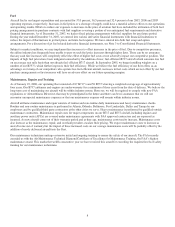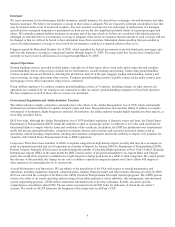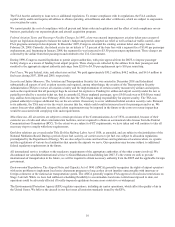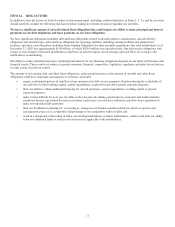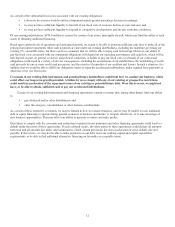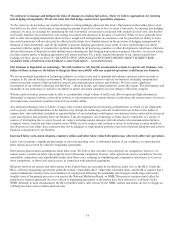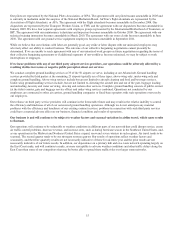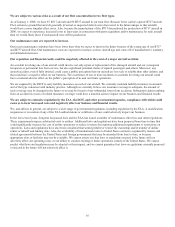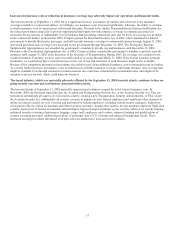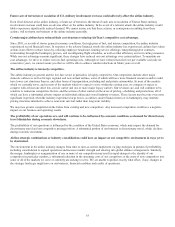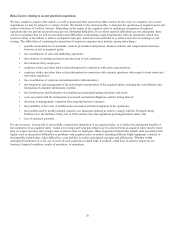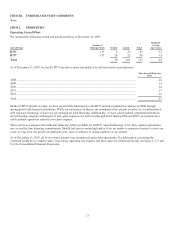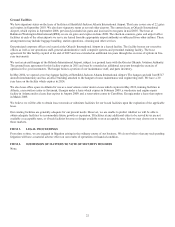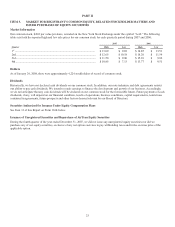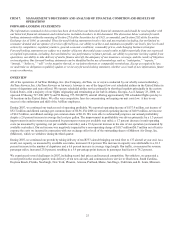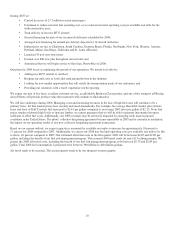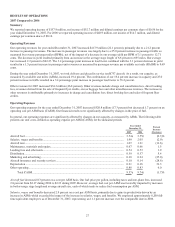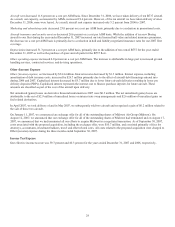Airtran 2007 Annual Report Download - page 24
Download and view the complete annual report
Please find page 24 of the 2007 Airtran annual report below. You can navigate through the pages in the report by either clicking on the pages listed below, or by using the keyword search tool below to find specific information within the annual report.
18
Future acts of terrorism or escalation of U.S. military involvement overseas could adversely affect the airline industry.
Even if not directed at the airline industry, a future act of terrorism, the threat of such acts or escalation of United States military
involvement overseas could have an adverse effect on the airline industry. In the event of a terrorist attack, the airline industry would
likely experience significantly reduced demand. We cannot assure you that these actions, or consequences resulting from these
actions, will not harm our business or the airline industry generally.
Certain major airlines have reduced their cost structures reducing AirTran’s competitive cost advantage.
Since 2001, as a result of slower general economic conditions, the high price of fuel, and intense competition, the airline industry
experienced record financial losses. In response to the adverse financial results the airline industry has experienced, airlines have taken
actions in an effort to reduce losses by, reducing employee headcount, limiting service offerings, renegotiating labor contracts,
restructuring through the bankruptcy process, and reconfiguring flight schedules, as well as other efficiency and cost-cutting measures.
While our cost advantage remains significant, these changes have reduced our cost advantage over certain airlines. To maintain our
cost advantage, we strive to reduce our non-fuel operating costs. Although we have reduced non-fuel cost per available seat mile six
consecutive years, we cannot assure you that we will be able to achieve similar reductions in future years or at all.
The airline industry is intensely competitive.
The airline industry in general and the low-fare sector in particular, is highly competitive. Our competitors include other major
domestic airlines as well as foreign, regional and new entrant airlines, some of which will have more financial resources and/or could
have lower cost structures than us, and other forms of transportation, including rail and private automobiles. In most of the markets
which we currently serve, and in most of the markets which we expect to serve within the coming year, we compete or expect to
compete with at least one other low-cost air carrier and one or more major legacy carriers. Our revenues are, and will continue to be,
sensitive to numerous competitive factors, and the actions of other carriers in the areas of pricing, scheduling and promotions, all of
which can have a substantial adverse impact on individual airline and overall industry revenues. These factors may become even more
significant in periods when the industry experiences large losses, as airlines, under financial stress or in bankruptcy, may institute
pricing structures intended to achieve near-term survival rather than long-term viability.
We may face greater competition in the future from existing and new competitors. Any increased competition could have a negative
impact on our business and operating results.
The profitability of our operations are, and will continue to be, influenced by economic conditions as demand for discretionary
travel diminishes during economic downturns.
The profitability of our operations is influenced by the condition of the United States economy, which may impact the demand for
discretionary travel and our competitive pricing position. A substantial portion of our business is discretionary travel, which declines
during economic downturns.
Airline strategic combinations or industry consolidations could have an impact on our competitive environment in ways yet to
be determined.
The environment in the airline industry changes from time to time as carriers implement varying strategies in pursuit of profitability,
including consolidation to expand operations and increase market strength and entering into global alliance arrangements. Similarly,
the merger, bankruptcy or reorganization of one or more of our competitors may result in rapid changes to the identity of our
competitors in particular markets, a substantial reduction in the operating costs of our competitors or the entry of new competitors into
some or all of the markets we serve or currently are seeking to serve. We are unable to predict exactly what effect, if any, changes in
the strategic landscape might have on our business, financial condition and results of operations.


